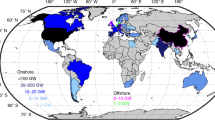Abstract
With increasing installation of wind turbines, the exposure to the hazard of impact from blade fragments increases. Local authorities use setbacks to reduce the risk by limiting the distance from wind turbines to adjacent property lines and dwellings. Unduly conservative setbacks are a deterrent to wind energy development. To determine appropriate setbacks, the authors developed a fragment trajectory model based on fragment rotation and aerodynamics. The model was used to simulate fragment trajectories at various rotor speeds, with randomly generated inputs for wind speed, wind direction, rotor azimuth, and rotor break position. Four sizes of wind turbines were studied, with rated power of 750 kW, 1.5, 3 and 5 MW. A sensitivity analysis showed that a fragment trajectory is highly dependent on the input parameters. However, for multiple trajectories from a given turbine and rotor speed, the sensitivity of the impact probability to most inputs was negligible. The results indicate that the range increased with turbine rating and rotor speed. When the range was normalized by overall turbine height, the probability of impact at a particular normalized range decreases with turbine rating. Planning agencies use the normalized range for setbacks, and the results indicate that using a common setback for all turbine sizes would be reasonable. Existing setback standards of 2–3 overall turbine heights offer better than 1 in 1,000,000 probability of impact per year; however, setbacks approaching 1 turbine height will have an order of magnitude higher probability of impact.







Similar content being viewed by others
References
Anonymous (2005) Wind turbines: part 1: design requirements. IEC 61400–1 Ed. 3, International Electrotechnical Commission, Switzerland
Braam H, van Mulekom G, Smit R (2005) Handboek risicozonering Windturbines. Technical report, SenterNovem, Netherlands
Eggers AJ, Holley W, Digumarthi R, Chaney K (2001) Exploratory study of HAWT blade throw risk to nearby people and property. In: 2001 ASME wind energy symposium, number AIAA-2001-0061, Reno, Nevada, USA
Fritzsche AF (1989) The health risks of energy production. Risk Anal 9(4):565–577
Gipe P (1995) Wind energy comes of age. Wiley, Hoboken, NJ
Huesemann MH (2003) The limits of technological solutions to sustainable development. Clean Technol Environ Policy 5(1):21–34
Larwood S, van Dam C (2006) Permitting setback requirements for wind turbines in California. CEC-500-2005-184, California Energy Commission, Sacramento, CA
Lin N, Vanmarcke E (2008) Windborne debris risk assessment. Probab Eng Mech 23:523–530
Macqueen JF, Ainsilie JF, Milborrow DM, Turner DM, Swift-Hook PD (1983) Risks associated with wind-turbine blade failures. IEE Proc A 130(9):574–586
Malcolm DJ, Hansen AC (2006) WindPACT turbine rotor design study June 2000–June 2002. NREL/SR-500-32495, National Renewable Energy Laboratory, Golden, Colorado, USA
Montgomerie B (1982) Horizontal axis wind turbine blade failure, blade fragment six degrees of freedom trajectory, site risk level prediction. In: 4th International symposium on wind energy systems, vol 2. BHRA Fluid Engineering, Stockholm, Sweden, pp 389–401
Nyberg M (2014) Total electricity system power. http://www.energyalmanac.ca.gov/electricity/total_system_power.html. Accessed 27 May 2014
Ramoni MO, Zhang H-C (2013) End-of-life (EOL) issues and options for electric vehicle batteries. Clean Technol Environ Policy 15(6):881–891
Rogers J, Slegers N, Costello M (2012) A method for defining wind turbine setback standards. Wind Energy 15(2):289–303
Slegers N, Rogers J, Costello M, Puga M, Arons P (2009) Modeling the risk of a failed wind turbine blade impacting a power transmission line. Wind Eng 33(6):587–606
Sørensen JN (1984) On the calculation of trajectories for blades detached from horizontal axis wind turbines. Wind Eng 8(3):160–175
Turner DM (1986) A Monte Carlo method for determining the risk presented by wind turbine blade failures. Wind Eng 11(1):1–20
Turner DM (1989) An analysis of blade throw from wind turbines. In: Swift-Hook PD (ed) Wind energy and the environment. Peter Peregrinus Ltd., London, pp 112–135
Wiser R, Bolinger M (2013) 2012 Wind technologies market report. U. S. Department of Energy, Washington, DC, Technical report
Author information
Authors and Affiliations
Corresponding author
Rights and permissions
About this article
Cite this article
Larwood, S., van Dam, C.P. Wind turbine rotor fragments: impact probability and setback evaluation. Clean Techn Environ Policy 17, 475–484 (2015). https://doi.org/10.1007/s10098-014-0805-9
Received:
Accepted:
Published:
Issue Date:
DOI: https://doi.org/10.1007/s10098-014-0805-9




